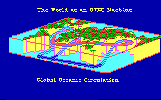NATURAL ENERGY DEFINED
Many, if not most believe that a sufficient condition for the production
of coherent, ordered, purposeful energy is the availability of masses of hot
matter. But hot matter by itself is nothing more than a mass of energetic chaos
without rhyme or reason or order. Therefore there is no ability to conduct
useful repetititive work. To obtain order and useful work it is necessary to
have masses of less energetic chaos or cold chaos. When the hot energy mass
interacts with the cold mass and is cooled then the energy (kinetic and
potential) can flow through coherent ordered structures such as turbines, or
waterfall, or hurricanes, or icebergs, or mountain - valley configurations and
coherent energy appears in the form of rain, wind wave, climate weather, the
production of biomass, etc. In the alternative it can be stored in reservoirs of
potential energy such as lakes, deep ocean water, saline fluids, biomass, living
plants and animals etc.
The amount of the hot chaotic energy that can be converted into coherent
energy depends upon the difference in temperature between the cold mass and the
hot mass. Scientists refer to this difference as Delta T. The greater this
difference the more ordered energy can be produced. In more scientific terms
this is called the Carnot efficiency and it is given by the simple equation
T1-T2/T1 where T1 is the absolute temperature of the hot mass of the fluid and
T2 is the temperature of the cold mass of the fluid.
We may now visualize the manner in which the earth produces natural energy.
Fortuitously, the earth has been set into rotation on a twenty four hour cycle.
Thus it is heated by the sun around an equator which shifts from the tropic of
Capricorn to the Tropic of Cancer every 365 days. The surface waters of the
equator thus constitute the mass of hot chaos with the temperature T1. This heat
is rejected at the poles or at the outer limits of the atmosphere.
 As the illustration shows, the hot
chaos that is the water at the equator flows at the surface as though it were on
a giant conveyor belt which, where the continents allow it, makes its way to the
poles. As a consequence there is hot tropical water around the world in the
regions of the tropics and cold arctic or antarctic water a scant 1000 meters
below. The sharp change in temperature with depth is called the thermocline.
As the illustration shows, the hot
chaos that is the water at the equator flows at the surface as though it were on
a giant conveyor belt which, where the continents allow it, makes its way to the
poles. As a consequence there is hot tropical water around the world in the
regions of the tropics and cold arctic or antarctic water a scant 1000 meters
below. The sharp change in temperature with depth is called the thermocline.
When the hot masses of surface water meet the cold masses of the atmosphere
or the cold arctic water then nature dissipates the heat and produces energy in
the form of hurricanes, tornadoes, rain, wind, wave, climate, atmospheric
fronts, The dissipation of the heat is inexorable and the generation of ordered
energy fixed by the Carnot equation. If we could somehow transform this ordered
energy into beneficial energy then we would meet the goal of environmentally
sustainable development.


These maps, West
and East, show the
distribution of Delta T around the globe.
It was with this motivation that the State of Hawaii established the Natural
Energy Laboratory of Hawaii (NELH). It was initially believed that economically
viable electrical energy could be obtained from the temperature difference
between the warm tropical energy wagers and the deep ocean. The initial, now
familiar resource map of the CHC logo shows the oceanic regions of the world for
which this condition exists. But we now realize that the generation of
electrical energy may be one of the lesser energy forms that can result from the
earths natural energy machine.
Indeed we now realize that the primary energy resource is the deep ocean
water which is below the photic zone and thus pure. It is cold (very close to
freezing) and by virtue of the general vertical distribution of water density,
it is rich in nutrients. As we shall many energy products can be produced
utilizing this 'elan vital' of the ocean.
Shortly before he died Kenji Okamura Japan's ocean technology ambassador met
with John Craven to assess the political and economic possibility of a joint
Japanese United States project to demonstrate self sufficiency, economic
viability, environmental sustainability for island and coastal communities while
retaining cultural identity. In his honor after this death this discussion
matured into the Okamura Craven Challenge to architects and coastal zone
planners to implement this concept as closely as the local geophysical
environment would allow. The Common Heritage Corp. repeats that challenge and
will demonstrate that it can be met for small coastal communities in the very
near future if all the known properties of deep ocean water are properly
integrated into the community design.
The system has been described and has been called theDOWER SYSTEM as natures
gift to humankind.
 As the illustration shows, the hot
chaos that is the water at the equator flows at the surface as though it were on
a giant conveyor belt which, where the continents allow it, makes its way to the
poles. As a consequence there is hot tropical water around the world in the
regions of the tropics and cold arctic or antarctic water a scant 1000 meters
below. The sharp change in temperature with depth is called the thermocline.
As the illustration shows, the hot
chaos that is the water at the equator flows at the surface as though it were on
a giant conveyor belt which, where the continents allow it, makes its way to the
poles. As a consequence there is hot tropical water around the world in the
regions of the tropics and cold arctic or antarctic water a scant 1000 meters
below. The sharp change in temperature with depth is called the thermocline.

